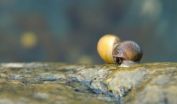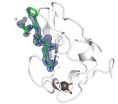(Press-News.org) Sexual conflict is not only a human phenomenon. Scientists at the University of Gothenburg have shown that females of the rough periwinkle conceal their gender identity in order to avoid excessive copulation.
The females of most species of snail excrete a substance in their mucous trails that enables males to find them more easily, since they can distinguish between trails from females and those from other males. The males follow the mucous trails laid down by females in order to find a partner for mating. However, the females of one of the species studied (Littorina saxatilis) have stopped labelling their mucous trails.
Males must search twice as long
"The consequence of this for the females is that they copulate less frequently, since the males often follow the trails of other males and must therefore spend twice as long looking for a female. This may appear strange at first sight, since we expect it to be in the females' interests to mate. But we show that copulation is costly for the females and that they already achieve more copulation than is required to fertilise all of their eggs", says Kerstin Johannesson, professor of marine ecology.
Scientists at Tjärnö have shown in a previous study that a snail may carry offspring that result from copulation with at least 20 males.
Less sex is beneficial for the females
The scientists have now been able to show that evolution has favoured those females who can conceal their gender identity. Females who can mask their trails copulate significantly less often than other females and thus have a greater chance of surviving.
"It is beneficial for males to mate as often as possible, since this is the only way in which they can influence the number of offspring they father. But it is costly for the females to mate often, and this is important for them in surviving during the period they are carrying offspring."
A situation in which individuals of different gender have conflicting interests is known as a "sexual conflict". Such conflicts can arise in various situations, and this is one of few examples of a sexual conflict in which the females attempt to conceal their gender. There are some other examples, including certain species of damselfly in which some of the females conceal their gender, simply by having the same colouring as the males.
The study of the remarkable behaviour of the rough periwinkle has been carried out by Kerstin Johannesson in collaboration with Sara Saltin, Iris Duranovic, Jon Havenhand and Per Jonsson at the Department of Marine Ecology, University of Gothenburg.
INFORMATION:
Female marine snails trick amorous males
2010-09-13
ELSE PRESS RELEASES FROM THIS DATE:
Your body recycling itself -- captured on film
2010-09-13
VIDEO:
This video shows UBR-box recognition of an arginine residue at the beginning of a protein (blue) targeted for degradation. The structural integrity of the UBR box depends on zinc (grey)...
Click here for more information.
Our bodies recycle proteins, the fundamental building blocks that enable cell growth and development. Proteins are made up of a chain of amino acids, and scientists have known since the 1980s that first one in the chain determines the lifetime ...
How football playing robots have the future of artificial intelligence at their feet
2010-09-13
The new Premier League season has begun and in Madrid the World Cup celebrations are barely over, yet according to research in WIREs Cognitive Science the world's best players may soon be facing a new challenge from football playing robots, which their creators claim will be able to play and beat a human team. The research reveals how building robots to play football is driving the development of artificial intelligence and robotic technology which can be used for roles including search and rescue and home help.
The author, Claude Sammut, from the ARC Centre of Excellence ...
Breakthrough in drug trial offers hope for heart attack patients
2010-09-13
New findings from a major drug trial have brought experts a step closer to developing a drug which could prevent thousands of British deaths from heart attacks.
Dr Robert Storey, Reader at the University of Sheffield and Consultant Cardiologist at Sheffield Teaching Hospitals, was the UK lead for international trials of a new drug, ticagrelor, which have been taking place over the last six years.
The new findings from one of these studies, the ONSET/OFFSET study, revealed that the platelet function in patients taking ticagrelor recovered much quicker after the drug ...
Brain stimulation can help partially paralyzed stroke patients regain use of their muscles
2010-09-13
Stroke patients who were left partially paralysed found that their condition improved after they received a simple and non-invasive method of brain stimulation, according to research in the September issue of the European Journal of Neurology.
Researchers from the Ain Shams University in Cairo, Egypt, studied 60 patients with ischaemic stroke - where the blood supply is reduced to the brain - who had been left with mild to moderate muscle weakness down one side of their body.
Twenty of the randomly assigned treatment group received repetitive transcranial magnetic ...
MIT researchers develop a way to funnel solar energy
2010-09-13
CAMBRIDGE, Mass. - Using carbon nanotubes (hollow tubes of carbon atoms), MIT chemical engineers have found a way to concentrate solar energy 100 times more than a regular photovoltaic cell. Such nanotubes could form antennas that capture and focus light energy, potentially allowing much smaller and more powerful solar arrays.
"Instead of having your whole roof be a photovoltaic cell, you could have little spots that were tiny photovoltaic cells, with antennas that would drive photons into them," says Michael Strano, the Charles and Hilda Roddey Associate Professor of ...
Engineers make artificial skin out of nanowires
2010-09-13
Berkeley – Engineers at the University of California, Berkeley, have developed a pressure-sensitive electronic material from semiconductor nanowires that could one day give new meaning to the term "thin-skinned."
"The idea is to have a material that functions like the human skin, which means incorporating the ability to feel and touch objects," said Ali Javey, associate professor of electrical engineering and computer sciences and head of the UC Berkeley research team developing the artificial skin.
The artificial skin, dubbed "e-skin" by the UC Berkeley researchers, ...
Cancer deaths fall, but prevention still lags behind
2010-09-13
Although overall mortality from cancer is decreasing in the European Union, its incidence increased by almost 20%, from 2.1 million new cases in 2002 to 2.5 million in 2008, says a special issue [1] of the European Journal of Cancer (the official journal of ECCO – the European CanCer Organisation) on cancer prevention, published today (Monday 13 September).
The current economic crisis threatens to affect cancer incidence in a number of areas, says a paper by Dr. José M. Martin-Moreno from the University of Valencia, Spain, and colleagues. Public donations to cancer ...
Scripps Research scientists solve long-standing mystery of protein 'quality control' mechanism
2010-09-13
LA JOLLA, CA – September 9, 2010 – Scientists from The Scripps Research Institute have solved a long-standing mystery of how cells conduct "quality control" to eliminate the toxic effects of a certain kind of error in protein production. The findings may lead to a better understanding of a host of neurodegenerative diseases.
The research was published in an advance, online issue of the journal Nature on September 12, 2010.
"It is exciting because we are dealing not only with a process that is clearly relevant for physiology and disease," said Scripps Research Assistant ...
Gene discovery could yield treatments for nearsightedness
2010-09-13
DURHAM, N.C. -- Myopia (nearsightedness) is the most common eye disorder in the world and becoming more common, yet little is known about its genetic underpinnings.
Scientists at Duke University Medical Center, in conjunction with several other groups, have uncovered a gene associated with myopia in Caucasian people from several different regions, including Dutch, British and Australian subjects.
Their work was published in Nature Genetics online on Sunday, Sept. 12.
Myopia happens when the focal point of an image falls just short of the retina at the rear of the ...
Henry Ford Hospital study: hVISA linked to high mortality
2010-09-13
A MRSA infection with a reduced susceptibility to the potent antibiotic drug vancomycin is linked to high mortality, according to a Henry Ford Hospital study.
Researchers found that patients who contracted a MRSA infection with heteroresistance, called hVISA, stayed in the hospital longer, were more likely to have the infection return after 90 days, and were twice as likely to die from it after 90 days than patients who do not have hVISA.
The study is being presented Sunday at the 50th annual Interscience Conference on Antimicrobial Agents and Chemotherapy in Boston.
"Based ...



